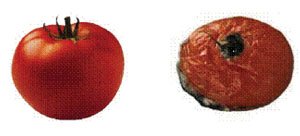8.5.3 Chemical spoilage
Chemical reactions in food are responsible for changes in the colour and flavour of foods during processing and storage. Foods are of best quality when they are fresh, but after fruits and vegetables are harvested, or animals are slaughtered, chemical changes begin automatically within the foods and lead to deterioration in quality. Fats break down and become rancid (smell bad), and naturally-occurring enzymes promote major chemical changes in foods as they age.
Enzymic spoilage (autolysis)
Every living organism uses specialised proteins called enzymes to drive the chemical reactions in its cells. After death, enzymes play a role in the decomposition of once-living tissue, in a process called autolysis (self-destruction) or enzymic spoilage. For example, some enzymes in a tomato help it to ripen, but other enzymes cause it to decay (Figure 8.8). Once enzymic spoilage is under way, it produces damage to the tomato skin, so moulds can begin to can attack it as well, speeding the process of decay.

Enzymic browning
When the cells of fruits and vegetables such as apples, potatoes, bananas and avocado are cut and exposed to the air, enzymes present in the cells bring about a chemical reaction in which colourless compounds are converted into brown-coloured compounds. This is called enzymic browning. If the food is cooked very soon after cutting, the enzymes are destroyed by heat and the browning does not occur. For example, apples are prone to discolouration if cut open when raw, but when cooked they do not go brown.
8.5.2 Physical spoilage
